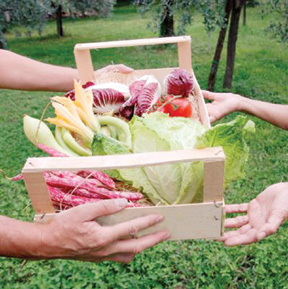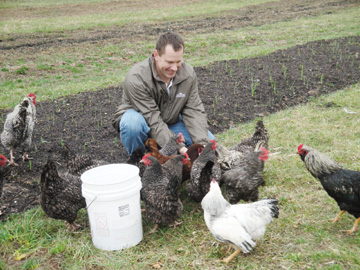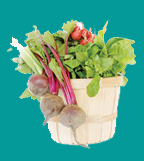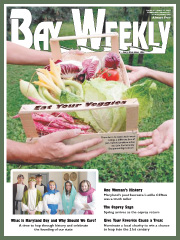Eat Your Veggies
From farmer to table, each week of the growing season brings
a different box of just-ripened vegetables, fruits and herbs
by Amy Russell
I have embarked on a great food experiment: I am teaching myself to cook. Until now, my culinary regime has been limited to three-ingredient crock-pot meals. With the help of gift cookbooks and guidance from family and friends, I think cooking is a goal I can reach.
But I’ve much to learn.
Last summer I went to my first farmers’ market, where I stumbled across heaps of strange-sounding vegetables: Arugula. Leeks. Overwhelmed, I paid for my common bell peppers and onions and headed home.
I know nothing about vegetables beyond the traditional broccoli and carrots. Knowing that I will have to branch out of those comforts if I really want to learn to cook, I thought back to that farmers’ market and decided that the next stop along my culinary journey would be to join Community Supported Agriculture.
Community Supported Agriculture is a partnership between a farmer and shareholders. Members front seed money at the beginning of the season, giving the farmer operating capital. In turn, membership brings a stake in the farm and a share of its produce. Each week of the growing season, members receive a box of whatever vegetables, fruits and herbs have just ripened.
From my boxes, I will not only learn to cook. I will also learn what to do with heretofore unknown ingredients.
I know the food will be local; it’s grown in my neighborhood. And I know it will be fresh.
The rest is unknown.
Shawn and Me
Once I made the decision to become a CSA member, I researched online and found the Sizer Farmstead, an acre-and-a-half farm in Davidsonville, not far from my home. Farmer Shawn Sizer and I are the perfect pair: We are both newbies to the Community Supported Agriculture community. A horticulturalist at heart, Sizer decided to start his farm — while keeping an office job — as a way to build family bonds.

Shawn Sizer, a first-year Community Supported Agriculture farmer, tends the chickens at his farm in Davidsonville.
|
“I wanted to reconnect with my three daughters, and I wanted them to understand about Mother Nature, ecology, ecosystems and how one thing in life is connected to everything else,” Sizer said. He rented a farmhouse with a big yard where he put in his first vegetable garden last year. It was successful beyond his wildest expectations.
“Last year, we cultivated about a third of an acre, and I couldn’t give it away fast enough,” Sizer said. “I have 21 employees at my other job, and I was filling my truck up each week to feed them. We were eating sweet corn on Halloween. We had about 150 plants of summer squash, and we gave it away or sold it by the crates. We still have some winter squash, potatoes and pumpkins from last year in our basement.”
With such abundance, Sizer wanted to share the wealth through community-supported agriculture. After a winter of research, he went seeking partners.
“There is nothing like pulling a carrot out of the ground that you have nurtured from inception, washing it off with the cold water from the garden hose and taking that first bite,” Sizer told me.
“The taste and personal accomplishment is so gratifying,” he said. “Who wouldn’t want to eat that kind of food every day?”
I sure do. I can’t wait!
Find Your Own CSA Farm
 Should you decide to embark on a journey of your own, Anne Arundel, Calvert and southern Prince George’s counties offer choices of Community Supported Agriculture farms. Some allow you-pick options, discounts in exchange for work, full and half shares and multiple pick up times and locations. Find a fuller list, expanding nationwide, at www.localharvest.org. Should you decide to embark on a journey of your own, Anne Arundel, Calvert and southern Prince George’s counties offer choices of Community Supported Agriculture farms. Some allow you-pick options, discounts in exchange for work, full and half shares and multiple pick up times and locations. Find a fuller list, expanding nationwide, at www.localharvest.org.
Clagett Farm, Upper Marlboro
Carrie Vaughn: 301-627-4662; www.clagettfarm.org; [email protected]
$490/year + $50 new membership fee (pick up at farm)
$550/year + $50 new membership fee (Dupont Circle drop off)
The 285-acre Clagett Farm is owned and operated by the Chesapeake Bay Foundation. The farm grows a full array of vegetables, raises grass-fed cattle and is home to a native tree nursery. In 1992, the Chesapeake Bay Foundation teamed up with the Capital Area Food Bank to provide free or reduced-price produce to communities in need throughout the Capital region. “We distribute 40 to 50 percent to low-income families. A lot of that is through donations directly to soup kitchens, homeless shelters and other agencies,” says Carrie Vaughn, vegetable production manager.
The remaining produce is sold through the CSA, usually about 200 shares. The CSA offers a reduced share rate in exchange for work and reduced price shares for low-income households.
“People like the fresh food. It’s healthy, and kind of stares at them in their refrigerator and encourages them to eat healthy,” Vaughn says.
Lamb’s Quarter, Owings
James Bourne: 410-257-4399; www.thelambsquarter.com
24 weeks: pick-up options
$625 full share; $400/12 week summer share.
Entering into its third year, Lamb’s Quarter is owned and operated by the Bourne family. The 145-acre farm — in the Bourne family since 1690 — hosts 75 shares. Meat and egg shares are offered in addition to vegetables. “We’re really excited,” says farmer James Bourne. “We have a lot of interest in meat, which is new this year.”
Ivy Brand, Edgewater
www.ivybrand.com
Ivy Brand is shared up and not accepting new memberships, but there is a waiting list for families within five miles of the 21037 Edgewater zip code. The waterfront family farm was Certified Organic in 2009. Leftover or unclaimed shares are donated each week to local shelters.
Jug Bay Market Garden, Upper Marlboro
Scott Hertzberg: 301-627-6211
20-22 weeks
$700 for drop-off at Capitol Hill
$600 for pick-up at Jug Bay Market Garden
Cut flower share: $150 additional
Offers reduced cost of share for work exchange
Jug Bay Market Garden is a family-owned CSA 20 miles outside D.C. It is a multi-farm CSA, meaning it incorporates produce from several local farms. The Market Garden is Certified Naturally Grown, which means farmers use only natural pest and disease controls.
Sizer Farmstead, Davidsonville
Shawn Sizer: 301-674-5316
23 weeks: pick-up only; after 4pm
$700 full share; $380 half share
The small first-time CSA offers 30 vegetable shares and 20 egg shares. “I believe in taking baby steps, and I can always expand next season,” says Sizer.
–Amy Russell
|
So I signed up, along with 29 others, and now we’re counting on Sizer’s skill and luck — and Mother Nature’s good graces — because we know that we’re sharing his risks of a poor season along with his hope for the bounty of a plentiful one.
From Tiny Seeds, Big Things Sprout
Community Supported Agriculture began about 60 years ago in Japan when people grew concerned about the safety and the quality of imported food. The idea hopped to Europe and, in the late 1980s, America joined the wave. Today more than 1,000 farms operate as CSA farms in America. Another 12,000 are linked to a CSA in some way or another, according to the National Agriculture Library.
The movement has caught on because, Sizer said, “it rekindles a basic human instinct that most Americans have forgotten about — knowing your food and where it comes from.” At the personal level, he says “people like the fact that they get to meet the person who grows the food they eat and even get to help produce their own food. They can come out and see the pile of ground-up leaves, watch the chickens dig through it and eat the earthworms, see the chickens lay their eggs.”
“Come out when you like, take a look around,” Sizer invited. “It’s not the prettiest place yet, but wait till the gardens start growing and you see what you get.”
I accepted Sizer’s open-door invitation. I’ve met the farmer — and his chickens. Now I’m looking forward to meeting other members of my CSA. I’m hoping the weekly pick-ups create bonds that weave a community. I have big expectations, because Sizer has inspired me to believe that “People want to be a part of something that is good for themselves, the community and the environment.”
A little more practically, I hope to exchange (probably mostly collect) recipes. I also expect to learn what vegetables and herbs grow and taste the best during which seasons. I read something about summer squash on the list of veggies, and I wonder, have I been eating winter squash since November? Or is that summer squash, just out of season and not as yummy?
And will I enjoy pineapple-flavored tomatoes? That’s one of the oddities Sizer discovered after a member wondered if he would grow pineapples. Obviously farmer Sizer and I aren’t the only ones new to this.
Ready, Set, Cook
This spring, as we dive into this head first and for different reasons, each of us will be taking risks, different as they may be. While Sizer puts his neck on the line each week, my risk — beyond my initial investment of $380 for a half share — will be mostly culinary: Will I like these new vegetables? Will I learn to cook well? Will my experiment be a success?
Since joining, I’ve checked the Farmers’ Almanac and other weather predictors in hopes of a successful season. I’ve cleared room in the refrigerator, mailed away for several cooking magazines and email subscriptions, attended three Pampered Chef parties and spent many a Friday night roaming the isles of Bed, Bath and Beyond to ensure that I’m fully prepared and readily equipped for the venture.
As the farm-to-table movement brings more attention to the health value of eating locally grown food, it’s no wonder Community Supported Agriculture is growing in popularity. UMASSVegetable.org estimates that food bought in grocery stores travels an average of 1,300 miles from the farm where it was grown. Every state in the U.S. — even Florida and California, our prime growing states — imports 85 percent of its food from another state or country. In comparison, produce from a CSA is as fresh as if you’d picked it out of your neighbor’s backyard.
For 23 weeks starting May 25, I will pick up my box of in-season, farm-fresh fruits, vegetables, herbs, eggs and even honey. Each week in my kitchen, I’ll be forced by my treasures to step outside my comfort zone. Each week, I will investigate the contents and seek out recipes that incorporate all the ingredients — those familiar and not. For 23 weeks I will be eating well, and with a little luck, learning life lessons well beyond cooking. I’m banking on it.
I’ll check back with you this fall and let you know how I did. Wish me luck.
If you can’t wait until fall to see how Bay Weekly’s newest writer fared with her experiment, follow her weekly on her blog: a-russ.blogspot.com.
![]()




 Should you decide to embark on a journey of your own, Anne Arundel, Calvert and southern Prince George’s counties offer choices of Community Supported Agriculture farms. Some allow you-pick options, discounts in exchange for work, full and half shares and multiple pick up times and locations. Find a fuller list, expanding nationwide, at
Should you decide to embark on a journey of your own, Anne Arundel, Calvert and southern Prince George’s counties offer choices of Community Supported Agriculture farms. Some allow you-pick options, discounts in exchange for work, full and half shares and multiple pick up times and locations. Find a fuller list, expanding nationwide, at